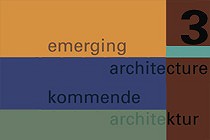
|
Emerging Architecture 3 - Kommende Architektur 3 Beyond Architainment Location: Architekturzentrum Wien - Old hall Exhibition: 21 November 2002 - 10 March 2003 Opening Hours: Daily 10:00 am - 7:00 pm, Wed until 9:00 pm Opening: Wednesday 20 November 2002, 7pm Feyferlik / Fritzer Glacisstraße 7 A - 8010 Graz AUSTRIA Phone +43-316-34 76 56 Fax +43-316-38 60 29 feyferlik@inode.at, fritzer@inode.cc Wolfgang Feyferlik born in Hausham/D in 1957; studied architecture at Graz TU. Buildings, projects (select): 'Solo' Housing Estate, Deutschlandsberg (competition 1st prize, together with Hubert Wolfschwenger), 1983 - 1993. 1983 - 1994: various houses (Graz, St.Anna, Vienna, etc.), and competitions (e.g. in Austria and Spain). Susi Fritzer born in Graz/A in 1967; studied architecture at Graz TU and at the Städelschule in Frankfurt. Buildings, projects (select): Europan 4, Palma de Mallorca, competition (2nd prize), 1997; Aachen Institute of Technology Students Center, competition (1st prize, together with Eva-Maria Pape), 2000. Collaboration since 1994. Joint buildings, projects (select): Basilica and Clerical House, Reorganization and Reconstructions, Mariazell, Styria, 1992 - 2007 Augarten Footbridge, competition, Graz, 1996 C. House, Graz, 1997 - 1999 Graz Town Hall, competition (purchase), 1999 Kunsthaus Graz, competition (purchase), 2000 Dr. D.'s Apartment, Vienna, 2001 Queensland Gallery of Modern Art, competition, Brisbane, 2001 R. House, Graz, 2000 - 2002 Relaxed Without Limits Expressiveness is not their cup of tea, nor is a form that would 'blast' borders. Wolfgang Feyferlik's early work and that developed with Susi Fritzer together represent a 'bodiless architecture'. They employ the material features of structures and envelopes as discretely, as porously as possible, in an attempt to unfold a spatial totality, organized in a way that is not burdened by materiality. Feyferlik once announced a vision to 'build up a magnetic field that does no harm to people and at once separates cold and warm areas, such that an envelope is created with that magnetic field alone, corresponding to the people's requirements for comfort.' This premise makes it clear how he, together with Fritzer, aspires to a minimum of material efforts to create the psycho-physiological requirements of dwellings. Contrary to classic modernity, the material is not abstracted; all building materials are applied and exploited according to their performance properties, their potentials tested with perfect ease. Moreover, the spatial continuum in Feyferlik/Fritzer's concept is not only horizontally isotropic, such as with Mies van der Rohe who formulated open space as sandwiched between a podium and abstractly floating roofing panels. [...] |
 |
|
|
|
Current Preview Permanent Exhibition Emerging Architecture 3 - Kommende Architektur 3 The 10 Teams * Feyferlik / Fritzer * AllesWirdGut * Holz Box Tirol * pool * one room huber / meinhart * PPAG * RATAPLAN * riccione * franz sam * weichlbauer / ortis Press Release: Emerging Architecture 3 - Kommende Architektur Gallery: Emerging Architecture 3 - Kommende Architektur 3 E-Shop Products: DVD: Emerging Architecture 3 - Kommende Architektur 3 Book: Emerging Architecture 3 / Kommende Architektur 3 Information: Ines Purtauf Tel.: +43 (1) 522 31 15 - 25 Fax: +43 (1) 522 31 17 Email: purtauf@azw.at |
| © Architekturzentrum Wien 2025 |
||



